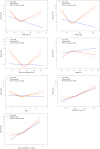The waist-to-body mass index ratio as an anthropometric predictor for cardiovascular outcome in subjects with established atherosclerotic cardiovascular disease
- PMID: 35039542
- PMCID: PMC8764082
- DOI: 10.1038/s41598-021-04650-5
The waist-to-body mass index ratio as an anthropometric predictor for cardiovascular outcome in subjects with established atherosclerotic cardiovascular disease
Abstract
Obesity is an independent risk factor for atherosclerotic cardiovascular disease (ASCVD). However, 'obesity paradox' is observed in patients with coronary artery disease while defining obesity by body mass index (BMI). The purpose of this study is to identify a better anthropometric parameter to predict cardiovascular events in patients with ASCVD. The study was conducted using the Taiwanese Secondary Prevention for patients with AtheRosCLErotic disease (T-SPARCLE) Registry. A total of 6,920 adult patients with stable ASCVD, enrolled from January 2010 to November 2014, were included, with a mean age of 65.9 years, 73.9% males, and a mean BMI of 26.3 kg/m2 at baseline. These patients were followed up for a median of 2.5 years. The study endpoint was the composite major adverse cardiovascular event (MACE), defined as cardiovascular death, nonfatal myocardial infarction or stroke, or cardiac arrest with resuscitation. Multivariable Cox proportional hazards regression showed a significant positive association between waist-to-BMI ratio and MACE (adjusted hazard ratio 1.69 per cm‧m2/kg increase in waist-to-BMI ratio, 95% CI 1.12-2.49, p = 0.01) after adjusting for potential risk factors and confounders. Traditional anthropometric parameters, such as BMI, weight, waist and waist-hip ratio, or newer waist-based indices, such as body roundness index and a body shape index, did not show any significant linear associations (p = 0.09, 0.30, 0.89, 0.54, 0.79 and 0.06, respectively). In the restricted cubic spline regression analysis, the positive dose-response association between waist-to-BMI ratio and MACE persisted across all the range of waist-to-BMI ratio. The positive dose-response association was non-linear with a much steeper increase in the risk of MACE for waist-to-BMI ratio > 3.6 cm‧m2/kg. In conclusion, waist-to-BMI ratio may function as a positive predictor for the risk of MACE in established ASCVD patients.
© 2022. The Author(s).
Conflict of interest statement
The authors declare no competing interests.
Figures

References
-
- Elagizi A, et al. An overview and update on obesity and the obesity paradox in cardiovascular diseases. Prog. Cardiovasc. Dis. 2018;61:142–150. - PubMed
-
- Hubert HB, Feinleib M, McNamara PM, Castelli WP. Obesity as an independent risk factor for cardiovascular disease: A 26-year follow-up of participants in the Framingham Heart Study. Circulation. 1983;67:968–977. - PubMed
-
- Wilson PW, D'Agostino RB, Sullivan L, Parise H, Kannel WB. Overweight and obesity as determinants of cardiovascular risk: The Framingham experience. Arch. Intern. Med. 2002;162:1867–1872. - PubMed
-
- Haslam DW, James WP. Obesity. Lancet. 2005;366:1197–1209. - PubMed
-
- Lavie CJ, Arena R, Alpert MA, Milani RV, Ventura HO. Management of cardiovascular diseases in patients with obesity. Nat. Rev. Cardiol. 2018;15:45–56. - PubMed
Publication types
MeSH terms
LinkOut - more resources
Full Text Sources
Medical

